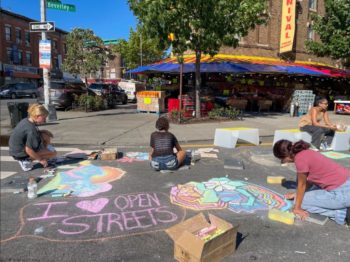
Image Credit: NYC DOT.
On August 29, 2024, New York City Department of Transportation Commissioner Ydanis Rodriguez announced the creation of 71 Open Streets at schools across the City. This record number of school-related Open Streets is the result of the New York City Department of Transportation’s $30 million investment to create and sustain high-quality public spaces like plazas and Open Streets, through the City’s Public Space Equity Program (PSEP). The City’s Public Space Equity Program aims to provide maintenance, horticultural care, financial subsidies, and Open Streets, plazas, and other spaces. The funding is allocated for low-income neighborhoods to advance placement of plazas and Open Streets across the city.
Open Streets create a safe space for children to play and learn and an efficient pick-up and drop-off area for parents and guardians. The newly available outdoor space provides room for a variety of activities. The initiative enhances pick-ups and drop-offs for parents and guardians by allowing participating schools to temporarily close streets to vehicles for drop-off and pick-up operations, recess, and outdoor learning. The full list of Open Streets: Schools locations can be found here.
Open Streets for Schools established a first of its kind legal structure which has was codified into law in the spring of 2024 to create streets for play and to support schools through the program. The Open Streets at Schools initiative has been fueled by a new partnership between New York City Department of Transportation and the nonprofit Street Lab. Street Lab in collaboration with schools helps launch and establish new Open Streets by helping with permits, planning with the school and community, and transforming streets with furniture, activities, and people. Street Lab’s efforts have yielded eight Open Streets for schools, with another 15 sites currently under exploration.
Beginning in 2025, the New York City Department of Transportation will offer funding to schools for Open Streets management, operations, and programming. Applications for 2025 Open Streets will open in October and details on how schools can apply for and receive funding will also be provided.
New York City Department of Transportation Commissioner Ydanis Rodriguez said, “The streets have historically been a place for children to play and socialize—and through our Open Streets program, we have created a new framework to give this space back to our school children to safely learn, develop new skills, and make pick-ups and drop-offs much easier for parents and guardians. This record achievement is thanks to our concerted effort to deliver new funding to the Open Streets program as well as our new partnerships with organizations like Street Lab, which help connect communities to this great concept and provide delightful programming for kids.”
Executive Director of Street Lab Leslie Davol said, “We’re seeing something beautiful on these Open Streets next to schools—kids, parents, caregivers, and teachers talking with each other, laughing, running through an obstacle course, even reading a book, all together on the street. This is about more than changing streets, it is about giving people the feeling of walking out the school doors into a public space that feels safer, healthier, and more connected. We’ve had a flood of requests from more schools that want to start an Open Street, and we’re aiming to work with as many as we can. Our approach prioritizes under-resourced neighborhoods and provides deep support so that these Open Streets can thrive and be embraced by the whole neighborhood. Street Lab also involves kids themselves in envisioning and leading these Open Streets, and it is absolutely inspiring to see their eagerness to improve their streets, their neighborhood, and the city itself. That may be the most exciting thing that’s happening here.”
By: Chelsea Ramjeawan (Chelsea is the CityLaw intern and a New York Law School student, Class of 2025.)

